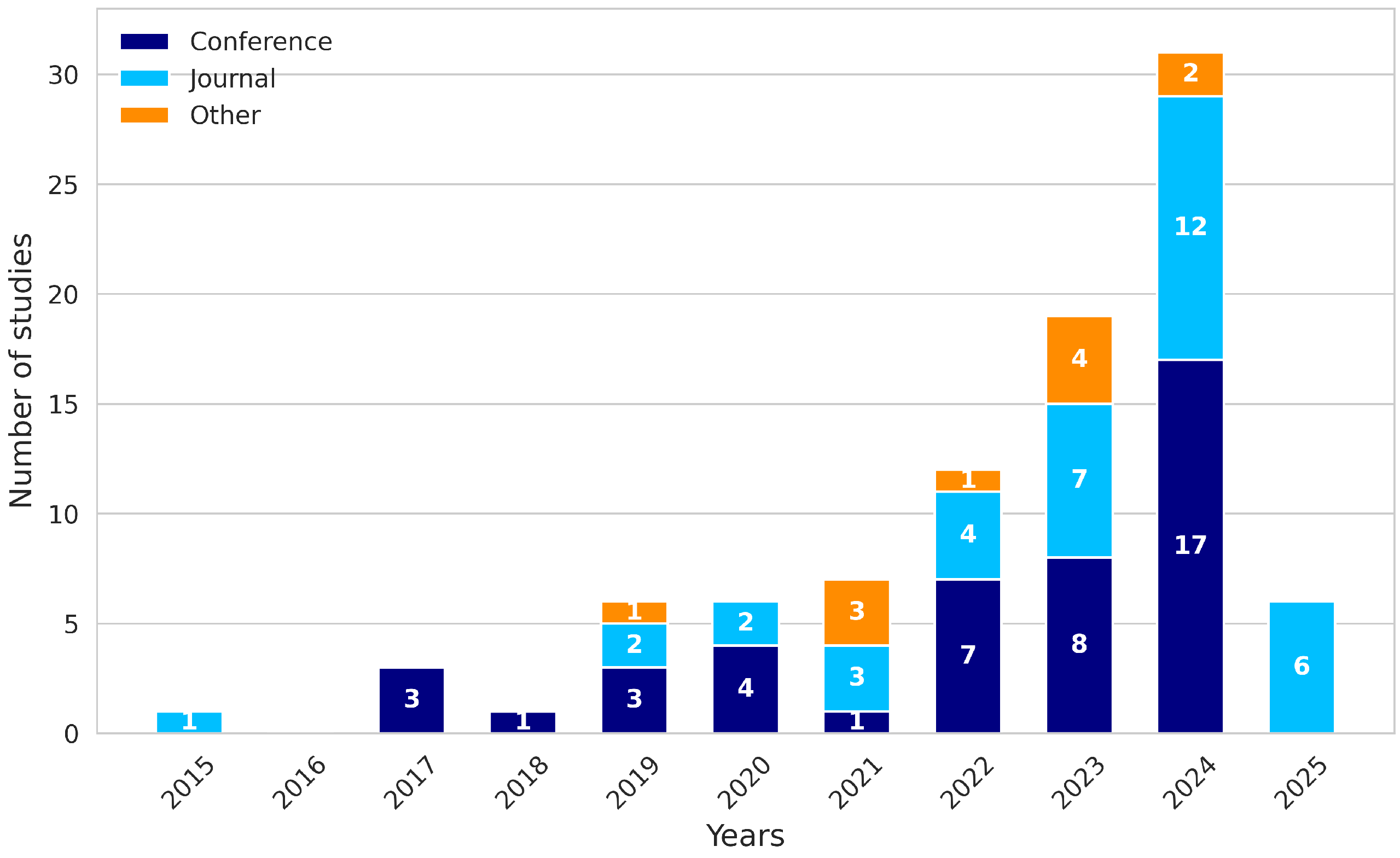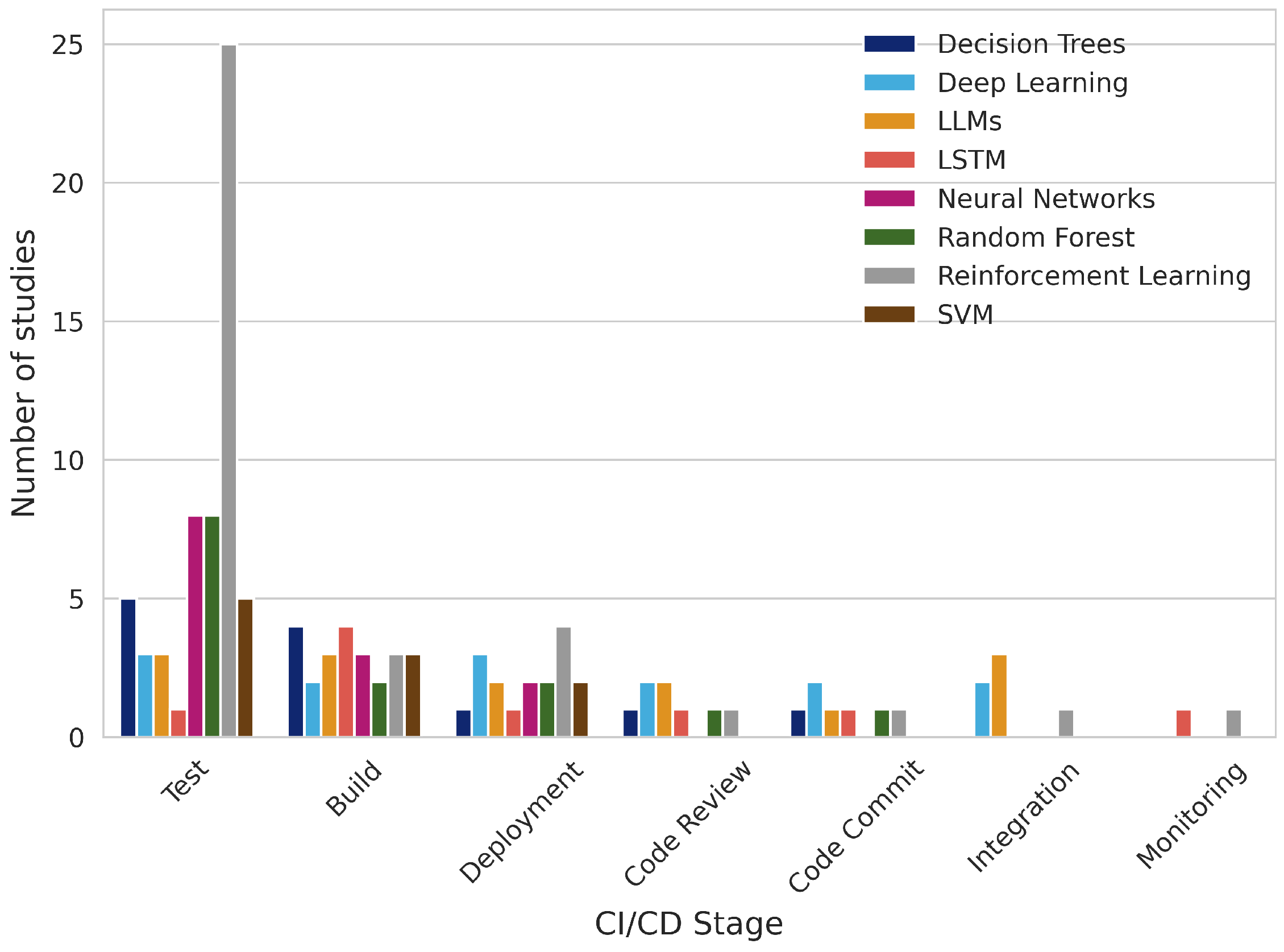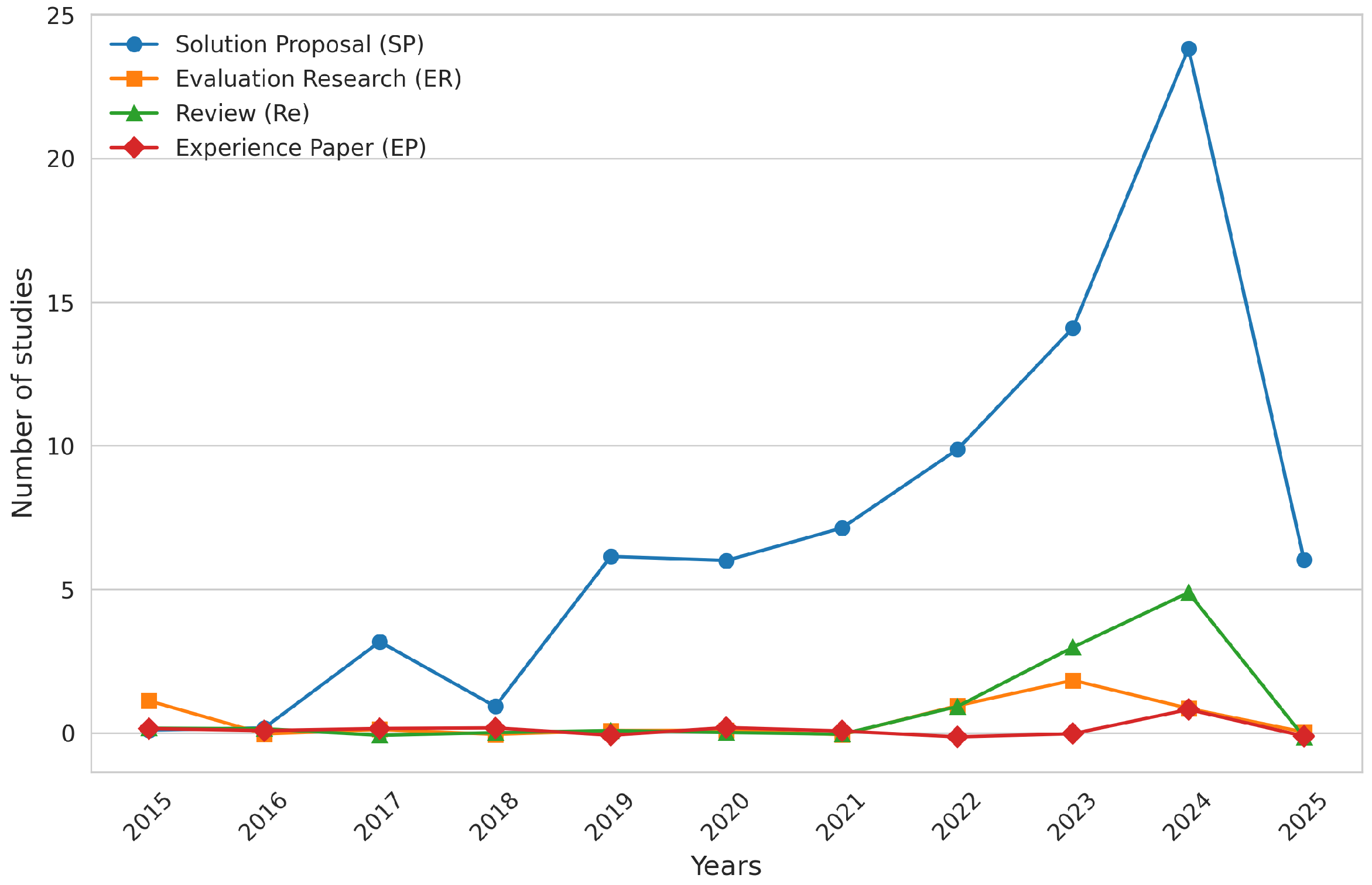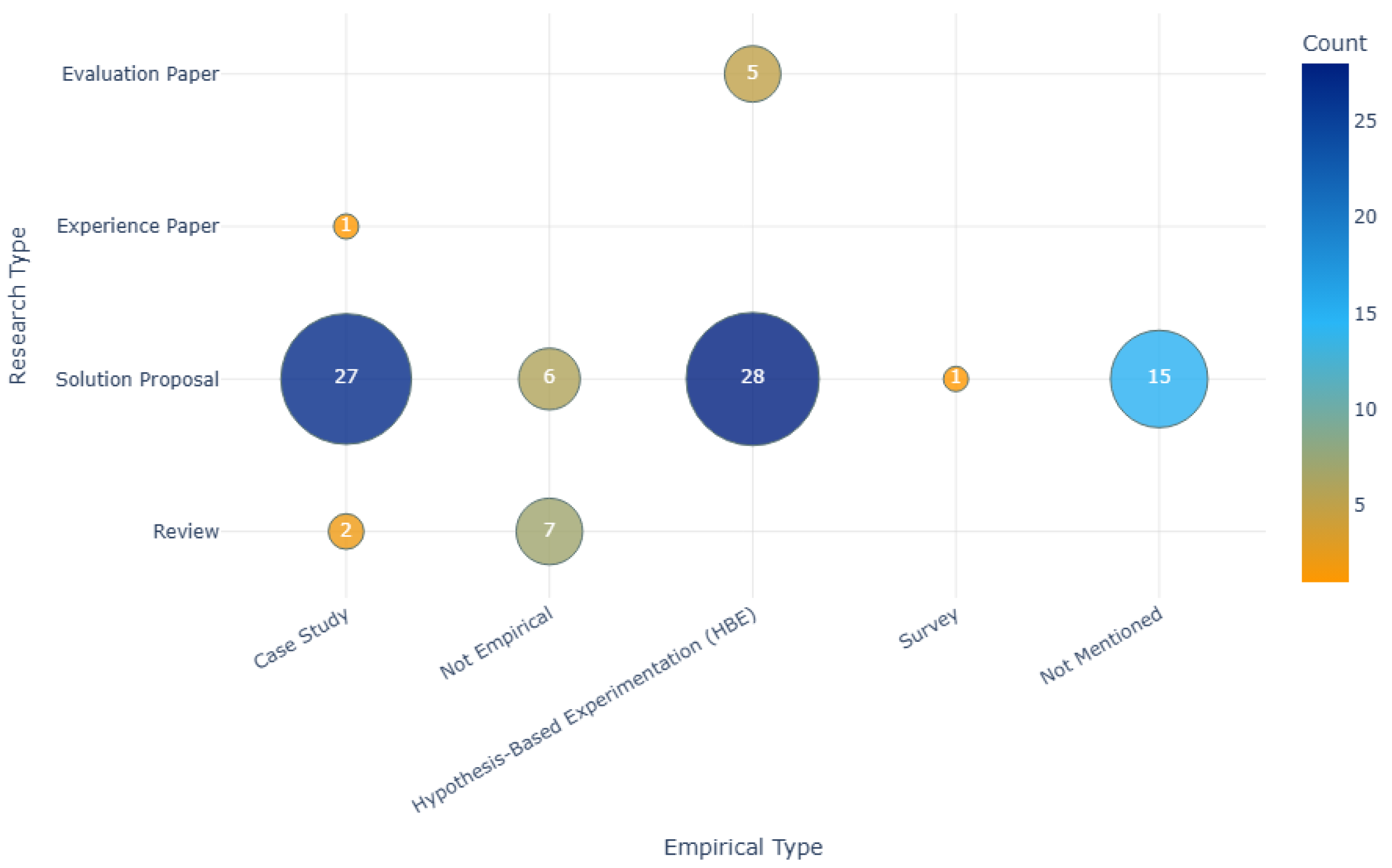CI/CD Pipeline Optimization Using AI: A Systematic Mapping Study †
Abstract
1. Introduction
2. Research Methodology
2.1. Research Questions
2.2. Study Selection
2.3. Data Extraction
- RQ1: Determine the year, channel, and source of each selected paper.
- RQ2: The CI/CD pipeline includes six key stages [14]:
- Code Commit: developers start by committing their code into a source code repository.
- Test: a set of tests to confirm the quality and functionality of the code.
- Code Review: reviewed all commits before merging to avoid future problems.
- Build: compiles the code into executables or bytecode files and generates artifacts that are well deployed.
- Deploy: when the code passes all the tests, it is ready to be deployed to staging/deployment environments.
- Monitor: check if the application is functioning as expected after deployment.
- RQ3: All AI techniques utilized in each selected study were identified.
- RQ4: The chosen papers are classified into [15]:
- Evaluation Research (ER): articles that evaluate the AI approach used for optimizing CI/CD pipelines by introducing new or using existing algorithms.
- Solution Proposal (SP): papers that submit a proposal solution or architecture based on AI for optimizing CI/CD.
- Experience Papers (EP): when the researchers share and discuss their practical experiences with CI/CD pipeline optimization using AI.
- Review: articles that review and summarize the current AI use in CI/CD optimization.
- RQ5: The type of empirical research is classified into 3 categories [16]:
- Survey: a series of questions is asked of the developers or DevOps engineers to see if there are any real benefits when using AI in the CI/CD pipeline.
- Historical-Based Evaluation: based on historical data from a study that manipulates AI in the CI/CD pipeline.
- Case Study: a study that evaluates their work empirically, such as the use of open-source projects.
2.4. Threats to Validity
- Study selection bias: although we applied rigorous selection criteria to ensure relevance, some relevant studies were missed. We included all other notable studies that we were able to identify by reviewing the references of the selected articles.
- Publication bias: since some researchers may exaggerate the efficacy of their AI models to show how efficient they are in comparison to others, we developed inclusion criterion 3 to focus also on studies comparing AI techniques to CI/CD pipeline improvements.
- Bias in data extraction: we began by reading the abstract if it was sufficient to discover the data needed to answer the RQs. If not, we continued reading the entire article to lower the possibility of inaccurate data extraction.
3. Results and Discussion
3.1. Studies Selection Process
3.2. RQ1: Where and in Which Year Were the Studies on Optimizing CI/CD Pipelines Using AI Published?
3.3. RQ2: Which Stage of the CI/CD Pipeline Benefits Most from AI Techniques for Their Optimization?
3.4. RQ3: What AI Techniques Have Been Applied to Optimize CI/CD Pipelines?
3.5. RQ4: What Types of Studies Have Been Published to Optimize CI/CD Pipelines?
3.6. RQ5: What Types of Empirical Research Were Employed to Evaluate the Optimization of CI/CD Based on AI?
4. Recommendations for Researchers
5. Conclusions
Author Contributions
Funding
Institutional Review Board Statement
Informed Consent Statement
Data Availability Statement
Conflicts of Interest
References
- Humble, J.; Farley, D. Continuous Delivery: Reliable Software Releases Through Build, Test, and Deployment Automation; Addison-Wesley: Upper Saddle River, NJ, USA, 2010. [Google Scholar]
- Shahin, M.; Ali Babar, M.; Zhu, L. Continuous Integration, Delivery and Deployment: A Systematic Review on Approaches, Tools, Challenges and Practices. IEEE Access 2017, 5, 3909–3943. [Google Scholar] [CrossRef]
- Fitzgerald, B.; Stol, K.J. Continuous Software Engineering: A Roadmap and Agenda. J. Syst. Softw. 2017, 123, 176–189. [Google Scholar] [CrossRef]
- Hilton, M.; Tunnell, T.; Huang, K.; Marinov, D.; Dig, D. Usage, Costs, and Benefits of Continuous Integration in Open-Source Projects. In Proceedings of the 31st IEEE/ACM International Conference on Automated Software Engineering, Singapore, 3–7 September 2016; pp. 426–437. [Google Scholar] [CrossRef]
- Shalev-Shwartz, S.; Ben-David, S. Understanding Machine Learning: From Theory to Algorithms; Cambridge University Press: New York, NY, USA, 2013. [Google Scholar] [CrossRef]
- Hany Fawzy, A.; Wassif, K.; Moussa, H. Framework for Automatic Detection of Anomalies in DevOps. J. King Saud Univ.-Comput. Inf. Sci. 2023, 35, 8–19. [Google Scholar] [CrossRef]
- Saidani, I.; Ouni, A.; Mkaouer, M. Improving the Prediction of Continuous Integration Build Failures Using Deep Learning. Autom. Softw. Eng. 2022, 29, 21. [Google Scholar] [CrossRef]
- Santolucito, M.; Zhang, J.; Zhai, E.; Cito, J.; Piskac, R. Learning CI Configuration Correctness for Early Build Feedback. In Proceedings of the 2022 IEEE International Conference on Software Analysis, Evolution and Reengineering (SANER), Honolulu, HI, USA, 15–18 March 2022; pp. 1006–1017. [Google Scholar] [CrossRef]
- Myllynen, T.; Kamau, E.; Mustapha, S.D.; Babatunde, G.O.; Collins, A. Review of Advances in AI-Powered Monitoring and Diagnostics for CI/CD Pipelines. Int. J. Multidiscip. Res. Growth Eval. 2024, 5, 1119–1130. [Google Scholar] [CrossRef]
- Yang, Y.; Pan, C.; Li, Z.; Zhao, R. Adaptive Reward Computation in Reinforcement Learning-Based Continuous Integration Testing. IEEE Access 2021, 9, 36674–36688. [Google Scholar] [CrossRef]
- Yaraghi, A.; Bagherzadeh, M.; Kahani, N.; Briand, L. Scalable and Accurate Test Case Prioritization in Continuous Integration Contexts. IEEE Trans. Softw. Eng. 2023, 49, 1615–1639. [Google Scholar] [CrossRef]
- Haneem, F.; Ali, R.; Kama, N.; Basri, S. Descriptive Analysis and Text Analysis in Systematic Literature Review: A Review of Master Data Management. In Proceedings of the 2017 International Conference on Research and Innovation in Information Systems, ICRIIS, Langkawi, Malaysia, 16–17 July 2017. [Google Scholar] [CrossRef]
- Petersen, K.; Feldt, R.; Mujtaba, S.; Mattsson, M. Systematic Mapping Studies in Software Engineering. In Proceedings of the 12th International Conference on Evaluation and Assessment in Software Engineering(EASE), Bari, Italy, 26–27 June 2008. [Google Scholar] [CrossRef]
- Jani, Y. Implementing Continuous Integration and Continuous Deployment (CI/CD) in Modern Software Development. Int. J. Sci. Res. 2023, 12, 2984–2987. [Google Scholar] [CrossRef]
- Brereton, P.; Kitchenham, B.A.; Budgen, D.; Turner, M.; Khalil, M. Lessons from Applying the Systematic Literature Review Process within the Software Engineering Domain. J. Syst. Softw. 2007, 80, 571–583. [Google Scholar] [CrossRef]
- Condori-Fernandez, N.; Daneva, M.; Sikkel, K.; Wieringa, R.; Dieste, O.; Pastor, O. A Systematic Mapping Study on Empirical Evaluation of Software Requirements Specifications Techniques. In Proceedings of the 2009 3rd International Symposium on Empirical Software Engineering and Measurement, Lake Buena Vista, FL, USA, 15–16 October 2009; pp. 502–505. [Google Scholar] [CrossRef]
- Spieker, H.; Gotlieb, A.; Marijan, D.; Mossige, M. Reinforcement Learning for Automatic Test Case Prioritization and Selection in Continuous Integration. In Proceedings of the 26th ACM SIGSOFT International Symposium on Software Testing and Analysis, Santa Barbara, CA, USA, 10–14 July 2017; pp. 12–22. [Google Scholar] [CrossRef]
- Su, Q.; Li, X.; Ren, Y.; Qiu, R.; Hu, C.; Yin, Y. Attention Transfer Reinforcement Learning for Test Case Prioritization in Continuous Integration. Appl. Sci. 2025, 15, 2243. [Google Scholar] [CrossRef]
- Benjamin, J.; Mathew, J.; Jose, R.T. Study of the Contextual Factors of a Project Affecting the Build Performance in Continuous Integration. In Proceedings of the 2023 Annual International Conference on Emerging Research Areas: International Conference on Intelligent Systems (AICERA/ICIS), Kanjirapally, India, 16–18 November 2023; pp. 1–6. [Google Scholar] [CrossRef]
- Bisong, E.; Tran, E.; Baysal, O. Built to Last or Built Too Fast? Evaluating Prediction Models for Build Times. In Proceedings of the 2017 IEEE/ACM 14th International Conference on Mining Software Repositories (MSR), Buenos Aires, Argentina, 20–21 May 2017; pp. 487–490. [Google Scholar] [CrossRef]
- Kaluvakuri, V.P.K. AI-Powered Continuous Deployment: Achieving Zero Downtime and Faster Releases. SSRN J. 2023. [Google Scholar] [CrossRef]
- Ochodek, M.; Staron, M. ACoRA—A Platform for Automating Code Review Tasks. E-Inform. Softw. Eng. J. 2025, 19, 250102. [Google Scholar] [CrossRef]
- Zhang, X.; Muralee, S.; Cherupattamoolayil, S.; Machiry, A. On the Effectiveness of Large Language Models for GitHub Workflows. In Proceedings of the 19th International Conference on Availability, Reliability and Security(ARES’24), Vienna, Austria, 30 July–2 August 2024; pp. 1–14. [Google Scholar] [CrossRef]
- Cao, T.; Li, Z.; Zhao, R.; Yang, Y. Historical Information Stability Based Reward for Reinforcement Learning in Continuous Integration Testing. In Proceedings of the 2021 IEEE 21st International Conference on Software Quality, Reliability and Security (QRS), Hainan, China, 6–10 December 2021. [Google Scholar] [CrossRef]
- Kawalerowicz, M.; Madeyski, L. Continuous Build Outcome Prediction: A Small-N Experiment in Settings of a Real Software Project. In Advances and Trends in Artificial Intelligence. From Theory to Practice; Lecture Notes in Computer Science (Including Subseries Lecture Notes in Artificial Intelligence and Lecture Notes in Bioinformatics); Springer: Cham, Switzerland, 2021; Volume 12799, pp. 412–425. [Google Scholar] [CrossRef]
- Arani, A.K.; Zahedi, M.; Le, T.H.M.; Babar, M.A. SoK: Machine Learning for Continuous Integration. In Proceedings of the 2023 IEEE/ACM International Workshop on Cloud Intelligence and AIOps, Melbourne, Australia, 15 May 2023. [Google Scholar] [CrossRef]
- S.R., D.; Mathew, J. Optimizing Continuous Integration and Continuous Deployment Pipelines with Machine Learning: Enhancing Performance and Predicting Failures. Adv. Sci. Technol. Res. J. 2025, 19, 108–120. [Google Scholar] [CrossRef] [PubMed]
- Benjamin, J.; Mathew, J. Enhancing Continuous Integration Predictions: A Hybrid LSTM-GRU Deep Learning Framework with Evolved DBSO Algorithm. Computing 2024, 107, 9. [Google Scholar] [CrossRef]
- Chen, T. Challenges and Opportunities in Integrating LLMs into Continuous Integration/Continuous Deployment (CI/CD) Pipelines. In Proceedings of the 2024 5th International Seminar on Artificial Intelligence, Networking and Information Technology (AINIT), Nanjing, China, 29–31 March 2024. [Google Scholar] [CrossRef]
- Zhao, Y.; Hao, D.; Zhang, L. Revisiting Machine Learning Based Test Case Prioritization for Continuous Integration. In Proceedings of the 2023 IEEE International Conference on Software Maintenance and Evolution (ICSME), Bogotá, Colombia, 1–6 October 2023; pp. 232–244. [Google Scholar] [CrossRef]
- Arani, A.K.; Le, T.H.M.; Zahedi, M.; Babar, M.A. Systematic Literature Review on Application of Learning-Based Approaches in Continuous Integration. IEEE Access 2024, 12, 135419–135450. [Google Scholar] [CrossRef]
- Yang, L.; Xu, J.; Zhang, H.; Wu, F.; Lyu, J.; Li, Y.; Bacchelli, A. GPP: A Graph-Powered Prioritizer for Code Review Requests. In Proceedings of the 39th IEEE/ACM International Conference on Automated Software Engineering (ASE ’24), Sacramento, CA, USA, 27 October–1 November 2024; ACM: New York, NY, USA, 2024; pp. 104–116. [Google Scholar] [CrossRef]
- Sharma, P.; Kulkarni, M.S. A Study on Unlocking the Potential of Different AI in Continuous Integration and Continuous Delivery (CI/CD). In Proceedings of the 2024 4th International Conference on Innovative Practices in Technology and Management (ICIPTM), Noida, India, 21–23 February 2024; pp. 1–6. [Google Scholar] [CrossRef]






| ID | Research Questions | Justifications |
|---|---|---|
| RQ1 | Where and in which year were the studies on optimizing CI/CD pipelines using AI published? | Determining publication channels and the timeline of research in AI-driven CI/CD pipeline optimization. |
| RQ2 | Which stage of the pipeline CI/CD benefits most from AI techniques for their optimization? | Identifying in which stage of the CI/CD pipeline AI is most useful. |
| RQ3 | What AI techniques have been applied to optimize CI/CD pipelines? | Identifying the most popular AI techniques used for CI/CD pipeline optimization. |
| RQ4 | What types of studies have been published to optimize CI/CD pipelines? | Categorizing the types of contributions in AI-driven CI/CD pipeline optimization. |
| RQ5 | What types of empirical research were employed to evaluate the optimization of CI/CD based on AI? | Determining the empirical study that is utilized to evaluate CI/CD optimization based on AI. |
| ID | Inclusion Criteria |
| IC1 | Articles that use or suggest new AI methods for CI/CD pipeline optimization. |
| IC2 | Papers that provide an overview of the use of AI in the optimization of the CI/CD pipeline. |
| IC3 | Publications that compare empirically or theoretically the AI approaches in CI/CD optimization. |
| ID | Exclusion Criteria |
| EC1 | Non-English papers. |
| EC2 | Articles posted before 2015. |
| EC3 | Papers are accessible only as abstracts or in PowerPoint. |
| EC4 | Duplicate papers. |
| Sources of Publications | # of Papers | (%) |
|---|---|---|
| Conferences | ||
| International Conference on Automated Software Engineering (ASE). | 4 | 4.35 |
| International Conference on Software Testing Workshops (ICSTW). | 3 | 3.26 |
| International Conference on Software Quality and Reliability and Security (QRS). | 2 | 2.17 |
| International Conference on Automation of Software Test (AST). | 2 | 2.17 |
| Other Conferences | 33 | 35.87 |
| Total Conferences | 44 | 47.82 |
| Journals | ||
| IEEE Access | 4 | 4.35 |
| Information and Software Technology. | 4 | 4.35 |
| Systems and Software. | 2 | 2.17 |
| IEEE Transactions on Software Engineering. | 2 | 2.17 |
| Other Journals | 25 | 27.17 |
| Total Journals | 37 | 40.21 |
| Other Sources | 11 | 11.97 |
Disclaimer/Publisher’s Note: The statements, opinions and data contained in all publications are solely those of the individual author(s) and contributor(s) and not of MDPI and/or the editor(s). MDPI and/or the editor(s) disclaim responsibility for any injury to people or property resulting from any ideas, methods, instructions or products referred to in the content. |
© 2025 by the authors. Licensee MDPI, Basel, Switzerland. This article is an open access article distributed under the terms and conditions of the Creative Commons Attribution (CC BY) license (https://creativecommons.org/licenses/by/4.0/).
Share and Cite
Farihane, R.; Chlioui, I.; Radgui, M. CI/CD Pipeline Optimization Using AI: A Systematic Mapping Study. Eng. Proc. 2025, 112, 32. https://doi.org/10.3390/engproc2025112032
Farihane R, Chlioui I, Radgui M. CI/CD Pipeline Optimization Using AI: A Systematic Mapping Study. Engineering Proceedings. 2025; 112(1):32. https://doi.org/10.3390/engproc2025112032
Chicago/Turabian StyleFarihane, Redouan, Imane Chlioui, and Maryam Radgui. 2025. "CI/CD Pipeline Optimization Using AI: A Systematic Mapping Study" Engineering Proceedings 112, no. 1: 32. https://doi.org/10.3390/engproc2025112032
APA StyleFarihane, R., Chlioui, I., & Radgui, M. (2025). CI/CD Pipeline Optimization Using AI: A Systematic Mapping Study. Engineering Proceedings, 112(1), 32. https://doi.org/10.3390/engproc2025112032






